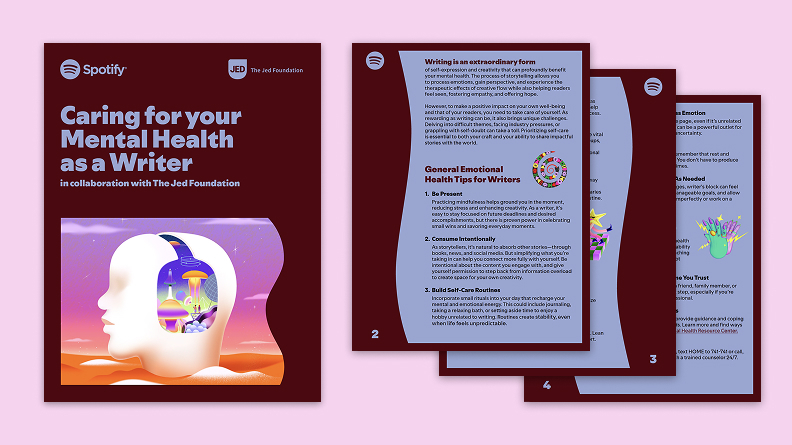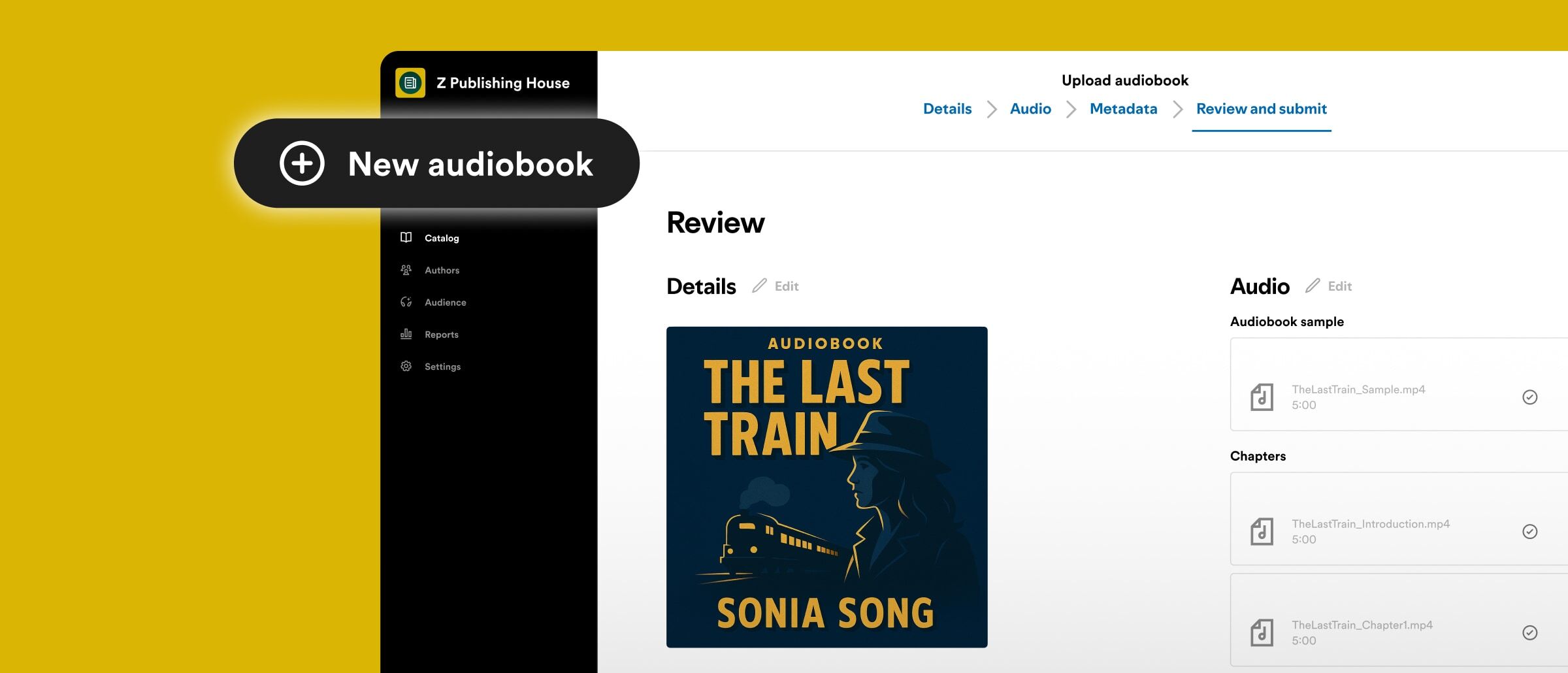Responsible mental health storytelling: A guide for authors

A recent study from The New School of Social Research suggests that reading fiction can reduce stress, lessen feelings of loneliness, and even improve our ability to understand others.
When written with care, stories about mental health can break down stigma and spark hope. That’s why writers matter—and why their well-being matters, too. While their words can change how people see themselves and others, authors often face unique emotional challenges without dedicated support (for instance, a Bookseller survey found that 54% of debut authors reported a negative impact on their mental health during the publication of their first book).
At Spotify, we believe in the transformative potential of thoughtful mental health narratives. Stories that portray characters with mental health challenges in their full humanity can help break down harmful misconceptions, foster understanding, and create meaningful connections with readers.
That’s why we partnered with The Jed Foundation, a non-profit organization that protects emotional health and prevents suicide for teens and young adults in the United States, and The Black List, a platform for writers to showcase their projects for industry professionals, to create resources for authors: Mental Health Storytelling Tips for Writers.
Because responsible storytelling begins with the storyteller, we've also partnered with The Jed Foundation to create a resource to support your own well-being throughout the writing process: Caring for your Mental Health as a writer.
In this article, we share strategies and considerations shared by the Jed Foundation and The Black List to help you craft mental health stories with confidence and care.
And for authors with unpublished manuscripts exploring mental health themes, we're happy to share the Spotify x JED Impact Award—an opportunity to receive funding and recognition for your work (more details at the end of this article).
For the complete guide on mental health storytelling tips, visit the official resource. For professional advice on taking care of your own mental health when tackling the subject, check out the official guide.

The power (and responsibility) of mental health storytelling
Stories shape how we see the world—and how we see ourselves. As a writer, you’re the one conveying the message. Your words, and the intention behind them, set the message in motion. Your art has power, and, like Uncle Ben once told us, with great power comes great responsibility.
A story that’s written with thoughtfulness and intention can challenge long-held misconceptions, offer hope to someone struggling in silence, or give readers the language to finally express what they're going through.
Maybe that’s a teenager reading about a character who shares their struggles with anxiety and realizing they're not alone. Or a reader discovering through a character's journey that seeking help isn't a sign of weakness. These moments matter. They can change how people think about mental health and, more importantly, how they think about taking care of themselves and others.
Every story that handles mental health with intention and compassion helps build a more understanding, empathetic world. Your manuscript could be part of this change.
Core principles for writing about mental health
We are sharing some of the top tips and tools for writing about mental health responsibly from our partners at The Jed Foundation and The Black List—helping people feel seen, fostering understanding, and inspiring hope. Below are key points to keep in mind:
Research and authenticity
Writing thoughtfully about mental health means understanding both expert knowledge and lived experiences. Even if you're drawing from personal experience, your characters' journeys will benefit from research and expert perspectives. Get acquainted with current terminology, common therapeutic approaches, and how specific conditions can affect daily life. Mental health organizations, academic resources, and reputable medical websites are a good place to start. For example, the Jed Foundation recommends:
- Mental Health Media Guide
- Digital Storytelling Guide
- The Jed Foundation’s Resource Center
- National Alliance on Mental Illness
- Mental Health UK
Consider connecting with mental health professionals early in your writing process rather than waiting until you have a completed manuscript. Having conversations during development can guide your storytelling choices from the beginning, helping you shape authentic characters and situations rather than needing to make corrections later. These professionals can help you refine therapeutic dialogue, ensure your portrayal of symptoms rings true, and catch outdated information or misconceptions. Sensitivity readers who share lived experiences with your characters also add layers of authenticity that research alone won’t provide.
Keep notes about your research so you can ground your story in reality. Which coping strategies would your character likely learn in therapy? How might their medication affect their daily routine? What support services would be available in their community?
Character development
Mental health affects your characters' lives, but it doesn't define them. A character who experiences depression isn't just their symptoms. They’re also their hobbies, their relationships, their victories, and their struggles. They’re people, people facing challenges—and though their challenges may be different, we all face them in different ways.
Developing characters with this level of care helps you avoid the harmful stereotypes that are sadly too prevalent in media (the "dangerous" person with mental illness or the character whose depression vanishes when they fall in love, to name an unfortunate few).
No two people experience mental health challenges the same way. Your job isn't to represent every possible experience but to tell one story authentically. The Jed Foundation suggests:
- Showing the full scope of your character's life—their relationships, ambitions, quirks, and daily routines
- Understanding how their mental health intersects with other aspects of their identity
- Depicting both their struggles and their moments of joy, connection, and triumph
When developing characters with audiobook production in mind, consider not just what they say, but how they might say it. A character experiencing anxiety might speak in rushed sentences during stressful situations, while someone with depression could have moments of slower, measured speech.
It might be worth nothing that conditions and challenges express themselves differently in behaviors. You can add directions for narrators that reflect how those behaviors of your character might translate to audio—these performance cues will help bring your characters to life for listeners and deepen the impact and relatability of your mental health storytelling.
Think about your own life and the lives of people you know. Mental health is a web created by many threads of thoughts, feelings, and experiences. The challenges are just a part of it, and your characters deserve the same depth.
Plot and story structure
Mental health narratives can powerfully center on a character's journey to recovery and healing. You just have to keep balance in mind by being as descriptive and visual with moments of hope and healing as you are with the struggles. The Black List suggests that readers need to see both the challenges and the path forward.
While your story may focus on mental health, remember that life happens between and outside of therapy sessions—friendships evolve, romance can blossom, there's room for adventure, idleness, and every chaotic, beautiful, mundane moment in between. Characters continue to have multifaceted experiences even as they navigate mental health challenges.
Give yourself permission to write a plot that reflects the fullness of human experience. Mental health can influence your character's decisions and relationships without overshadowing every scene—they might sleep through the morning alarm because of depression, but their day can still unfold into an unexpected adventure.
When considering your ending, aim for authenticity while still offering hope. Real progress often comes in small steps: having a difficult conversation, setting a boundary, a coping strategy that finally clicks. Moments like these hold tremendous power because readers recognize their own experiences in these victories. Your readers should finish your story with a sense that healing is possible, even if it's ongoing.
Your plot should also address setbacks. A stressful project might trigger old patterns, or a relationship ending could shake someone's stability. These aren't failures, just part of being a person dealing with mental health conditions. What matters is how your characters respond, adapt, and keep moving forward—showing that recovery isn't always linear but is always possible.
For audiobook storytelling, think about how pacing impacts the listener's experience. Moments of crisis might benefit from quickened dialogue and shorter sentences that convey urgency, while healing and reflection unfold through longer, more measured passages.
Make note of these pacing suggestions in your notes to narrators—little cues like '(speaking rapidly)' or '(pause)' guide the performance and help listeners feel your character's emotional journey. The great thing about the audio format is that it gives you these extra tools to mirror your character's mental state through rhythms of speech and meaningful silences.
Handling sensitive scenes
Certain moments in your story might involve intense emotional experiences, mental health crises, or trauma. Your responsibility as a writer is to handle these scenes thoughtfully—not for shock value or dramatic effect, but to serve the narrative.
The Jed Foundation suggested that many will have lived through similar experiences, and your portrayal might be their first time seeing their struggles reflected in fiction. You can make these scenes count by showing paths forward: how other characters in their orbit respond with compassion, what coping strategies help, or where to find support.
These scenes don't need to be big turning points. Sometimes a quiet moment of vulnerability between friends is more meaningful than a dramatic breakdown. Show these experiences with honesty while maintaining hope, not by minimizing the challenge, but by acknowledging that support exists and healing is possible (even when it feels like the opposite is true).
The craft: Language, genre, and technical considerations
Perhaps less exciting but just as important, technical elements like language choices and genre conventions shape how you can tell these stories with authenticity and care.
Language and representation
How you write about mental health matters just as much as what you write. Using person-first language ("a person who experiences anxiety" rather than "an anxious person") affirms that your characters are people first, not their diagnoses.
Similarly, avoiding casual terms like "crazy" or "OCD" as shorthand keeps you from minimizing real experiences and pushes back against lingering stigma.
Thoughtful representation can enrich stories across all genres. Depending on what you write, you'll find different opportunities to explore how mental health intersects with your characters' journeys:
Romance
Mental health might affect how your characters deal with relationships, but it shouldn't be a barrier to love or magically "fixed" by finding the right person. Show how healthy relationships require understanding, communication, and mutual support.
Your protagonist's anxiety might make them second-guess their crush's interest, but they can learn to navigate dating while managing their mental health. Their experience with therapy might even give them better emotional tools for building a healthy relationship.
Fantasy and Sci-Fi
You can explore mental health through metaphor, but be careful not to vilify these experiences or suggest that magic and/or space alien technology is the only solution. Ground your fantastical elements in emotional truth. Instead of a miracle cure, magical elements could represent real coping strategies (like a witch’s familiar grounding her during panic attacks).
Young Adult
Young readers are likely navigating their own mental health for the first time. Show them what healthy support systems look like, include characters who model how to ask for help, and demonstrate that mental health challenges don't make someone broken or unlovable.
Content guidance and reader support
Your story will likely touch on experiences that readers find challenging. While you shouldn't shy away from difficult topics, you can help them make informed choices about when and how they engage with your work.
Content notices and trigger warnings are great practices, as they let readers approach sensitive content on their own terms. For print and ebooks, you can add them to your book's description or as an author's note. For audiobooks, these notices can be included in:
- The audiobook description on platforms and storefronts
- A brief spoken acknowledgment at the beginning of the recording
- Chapter markers that flag potentially sensitive content sections
- Companion digital materials linked in the audiobook description
Be specific but not graphic. Something like "this story includes descriptions of panic attacks and discussions of self-harm" gives readers more than enough information.
You can also include resources naturally in your story. Characters might mention specific coping techniques, share helpful books, or discuss their experiences with support groups. A teenager might find solace in a mental health app, or a friend might share a crisis hotline number during a tough conversation.
A note on taking care of your own mental health while writing
Writing about mental health can stir up intense emotions, either because you're drawing from your own experiences or just deeply empathizing with your characters. But your well-being matters as much as your story—not just during challenging writing sessions, but throughout your creative journey.
The Jed Foundation suggests take to writing difficult content when you have support available, and try to balance heavier scenes with lighter moments. If you find yourself dwelling on tough topics after writing sessions, that's your cue to stop and re-think how you’re going about the process.
It’s okay to sometimes step away, take walks, call friends, or do whatever helps you recharge. If certain topics feel too close to home right now, you can always approach them differently or set them aside until you're ready.
The creative life comes with its own unique pressures and challenges. Establish sustainable writing routines, connect with fellow authors who understand your experiences, and don't hesitate to seek professional support when needed. Writing may be solitary work, but you don't have to navigate its emotional landscape alone.
We want to help your story be heard
Throughout this article, we've explored how thoughtful mental health storytelling can reduce stigma and offer authentic representation. Now, we want to celebrate authors who bring these principles to life in their work. The Spotify x JED Impact Award—a collaboration between Spotify, The Black List, and The Jed Foundation (JED)—will award five $10,000 grants to writers with unpublished manuscripts that bring fresh, thoughtful perspectives to mental health storytelling.
We're looking for fiction that moves beyond one-dimensional portrayals and shows the full humanity of characters navigating mental health experiences. If your manuscript explores mental health themes with the care and nuance we've discussed in this guide, we encourage you to apply.
The deadline for submissions is July 8, 2025. Submit your manuscript through The Black List platform and join us in creating more honest, nuanced conversations about mental health through fiction.
Tell your story on Spotify today
Create a Spotify for Authors account to get started.


